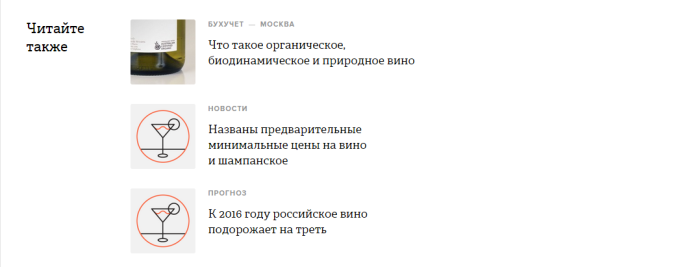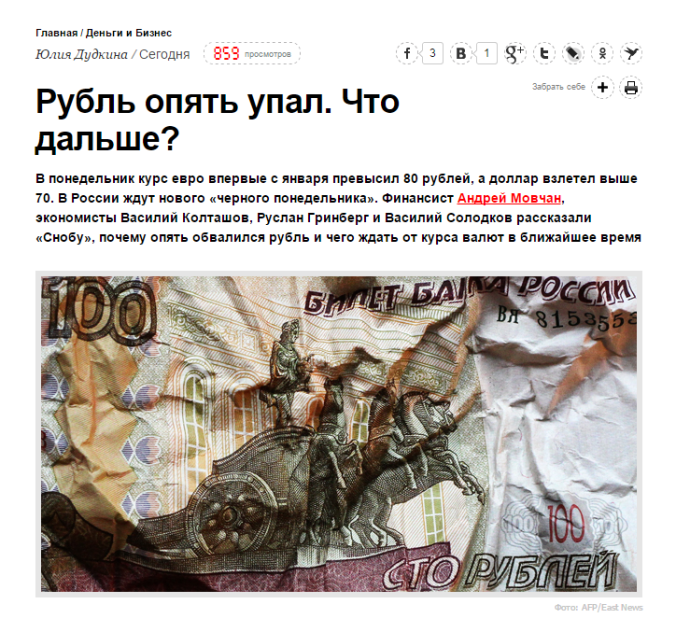How to make content recommendations: 5 mistakes of Russian media

In addition to the b2c project Surfingbird in our company there is a b2b product Relap . This is a media recommendation system. You could see our technology in action on Lifehacker , AdMe , RIA , COUB and other sites that you use every day. We help clients engage the audience in content consumption, using algorithms that have been developing for several years.
We often encounter misconceptions and myths about what should be the recommendations around the main content, for which the user comes. The article tells about the most common mistakes that media make when designing interfaces and how to do it correctly.
Recommend by tags
The biggest and most popular misconception. Most often, the media make recommendations at the end of an article by tags. So does Look At Me and RBC, for example. There is material with tags: tractor, Putin, cheese. Texts about a tractor, about Putin and cheese are displayed to him. At first glance, it is logical:
')


Such a recommendation in real life would look like this. You go to the grocery store. And put in the basket of butter. A consultant with sweaty palms palms comes up to you and says: “Oh, I see you have taken butter and that means you need butter. Take five more types of creamy rustic and sunflower and goat butter. ” The maximum that can happen out of the ordinary is that you will be offered a transmission if you read something about cars. And this will already be considered rocket science.
The world is a little more complicated. In fact, everything works like this: the user comes to the site, watches the dollar rate, the koobs from Mad Max and the video where someone throws chebureks. So, another person who has already looked at the dollar and Mad Max will most likely want to look at the flying cheburek, no matter how strange it may sound. This is called collaborative filtering. There are clusters of users and patterns with which you can maximize the reader’s involvement in your content.
According to the results of the A / V tests, collaborative filtering without additional settings gives 20-30% more clicks than selection by tags. And this means that no one should make “Read also” blocks based on tags.
Recommend content from the same section.
The second incarnation of the previous fallacy is to segment recommendations by sections.
Imagine that the consultant of the butter department takes you hostage with the words: “Today you will buy only butter, oh, yes, you will buy a lot of butter!” You shout out the door with a cry, and never come back to this store.
We showed segmented recommendations to one group of users: a person reads the news from the “Society” section - we recommend him articles only from the “Society” section. Another group received recommendations from the entire site (cross-segment recommendations). The CTR of the widget with recommendations without sections is 2 times higher, the failure rate is 16% lower and the time spent on the site was 23% higher. There is no point in restricting the reader to a single section. Be diverse in your recommendations.
Recommend popular
To recommend popular news means to recommend unnecessary news that everyone has already seen. Popular are materials that many people have watched. That is how popular is becoming popular. Every time you want to make such a block on your site, remember this sentence, because this is how it works. This is the news that everyone saw.
In the A / B tests, we compared popular and collaborative filtering. CTR widget with collaborative filtering is 7 times higher. This does not mean that our algorithms are so cool. This means that the block is popular on the site - sucks and does not need anyone at all. We understand that the “Popular” block on the site is a must have for most media, but it's time to say goodbye to this delusion.
Do not set a time limit
Why news publications recommend the news six months ago is difficult to understand. Such an approach generates wild examples of the type of this:


Media thinks the user wants to know what was on the subject before. No, he does not want! He is not interested, and no one is interested.
During the tests on the news media, we found out the most optimal age of news that should be recommended to visitors. Three options were tested: 72, 48 and 24 hours from the moment of publication. The test sample was 2.7 million readers and a month was spent. Most of our colleagues bet for 24 hours, because it seemed to them that the news very quickly became obsolete, and no one would read yesterday's news. Slightly less people believed in 48 hours. Apparently, because not everyone has time to read the actual for the day and, most likely, they missed something for yesterday and want to catch up. No one believed in 72 hours. Yes, 72 hours won. In this range, users find the most interesting materials and the blocks collected from such news are clickable by 4.2% more than 48 hours and 10.9% more than 24 hours. This is probably due to the fact that people do not have time (or simply do not want) to consume the entire amount of information generated by the media. Therefore, the news released the day before yesterday, they are still relevant. The exceptions are breaking news.
Make recommendations hands
“The algorithm can not be smarter than a person and know the needs of the audience better than a professional” - this is the average argument of those who collect recommendations with their hands.
We do not agree. People learned to fly to the moon, plant a satellite on a comet flying in space, more electric cars, supercomputers, robots, a hadron collider and all that. What hints about the triumph of technology around us. And so no, the algorithm knows best. So that the story does not turn into a dystopia, we will tell you how it works.
Each user does a little editor work. Once or twice a day, it goes to the resource, reads the news, and performs two or three internal transitions. The algorithm understands that the user likes and finds recommendations for him and for people with similar interests.
We conducted an A / B test, where we compared the work of the native media widgets with the recommendations. In the first case, the recommendations were collected by the editors. In the second, our automated widget worked. As a result, Relap increased the CTR of the unit by 2 times.
We are very pleased if this article has helped in the work of your editorial staff and interface design. If you have questions, crazy hypotheses and ideas that you want to implement with us - write to lab@relap.io.
If you want to use our technologies, engage readers and generally automate content recommendations on the site, we will be happy to help. Write to hello@relap.io.
Source: https://habr.com/ru/post/294218/
All Articles